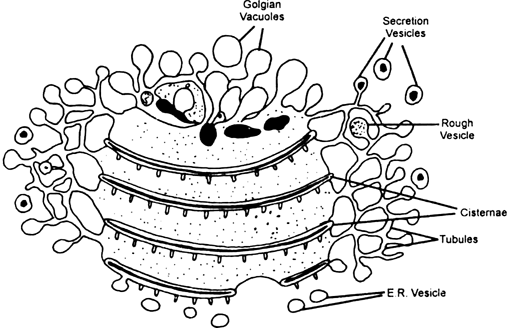 Short Answer Type
Short Answer Type Long Answer Type
Long Answer Type Short Answer Type
Short Answer Type Long Answer Type
Long Answer Type Short Answer Type
Short Answer Type Long Answer Type
Long Answer TypeOccurrence. The Golgi complex is found in all the eukaryotic cells of plants and animals. However, it is absent in prokaryotic cells. In higher animals it is situated between the nucleus and the cell membrane, while in invertebrates and some specialized cells of vertebrates such as nerve cells, liver cells etc., the Golgi complex is found scattered in the cytoplasm.
In the plant cells the Golgi complex consists of a number of unconnected structures known as dictyosomes. Hundreds of such dictyosomes are found scattered in the cytoplasm.
Structure - If observed under electron microscope the Golgi complex consists of the following components :
1. Cisternae. These are the tubular or flattened fluid filled sacs. The Golgi cisternae are concentrically arranged near the nucleus with distinct convex cis or the forming face and concave trans or the maturing face.
2. Vesicles. These are small drop-like structures associated with convex surface of the Golgi complex.

3. Tubules. These are branched structures which arise from periphery of cisternae.
4. Vacuoles. These are present on the sides and on the maturing surface of the Golgi complex. These are formed by the pinching of the cisternae of the Golgi complex. The vacuoles are filled with amorphous or granular substances.
 Short Answer Type
Short Answer Type Long Answer Type
Long Answer Type